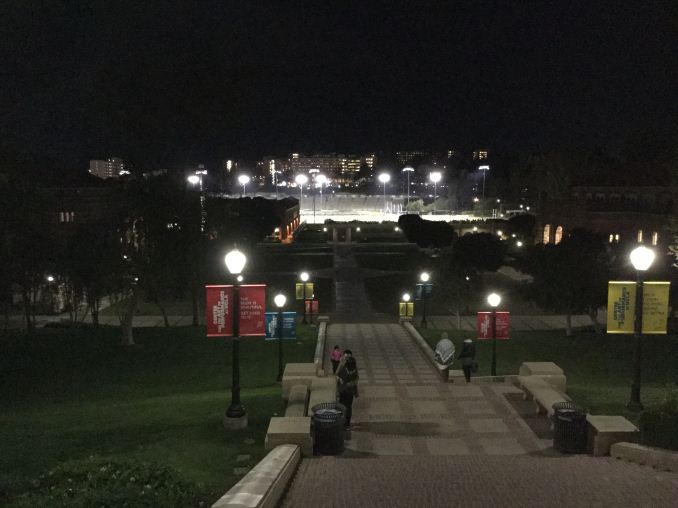The Apple iPad Air 2 Review
by Joshua Ho on November 7, 2014 9:30 AM EST- Posted in
- Tablets
- Apple
- Mobile
- iOS
- ipad Air 2
Camera
For better or worse, the camera on a tablet has become increasingly important. While there was a time when the cameras on tablets were solely used for video calls and similar functions where quality was of relatively low importance, there’s been a clear shift in the other direction. While I don’t think anyone is going to use their tablet as a primary camera, there is a level of convenience that comes with it. I’ve definitely found it to be rather intensely uncomfortable to use a tablet as a camera at all as it’s the furthest thing from inconspicuous. This brings us to the iPad Air 2, which brings the first notable camera change to the iPad line since the iPad 3, as seen below.
| Rear Facing Camera Comparison | |||||||
| Sensor | Resolution | Aperture | Focal Length | ||||
| Apple iPad Air 2 | 8 MP | 3264 x 2448 | f/2.4 | 3.3mm | |||
| Apple iPad Air | 5MP | 2592 x 1936 | f/2.4 | 3.3mm | |||
| Apple iPad 4 | 5MP | 2592 x 1936 | f/2.4 | 4.3mm | |||
| Apple iPad 3 | 5MP | 2592 x 1936 | f/2.4 | 4.3mm | |||
| Apple iPad 2 | 0.7MP | 960 x 720 | f/2.4 | 2.0mm | |||
| Apple iPad mini | 5MP | 2592 x 1936 | f/2.4 | 3.3mm | |||
While the iPad Air 2’s camera does have an eight megapixel output image, it’s important to distinguish this from the iPhone line as the sensor is noticeably smaller than what we see on something like the iPhone 6 and 6 Plus. Instead of 1.5 micron pixels, this gives us 1.1 micron pixels. In addition, the camera lacks PDAF, so focus times will definitely take a fall as a result. On the flip side, this also means no camera hump on the back.
While focus times are one thing, the difference in pixel sensitivity is likely to be the biggest difference. In casual testing, the ISO of the rear-facing camera goes between 25 and 800 ISO, and the front-facing 1.3MP camera will vary between 50 and 2000 ISO. As the tablet lacks optical stabilization, Apple has capped exposure time to a maximum of 1/15 seconds similar to what we see with the iPhone 6.
As one might guess, this difference in sensitivity doesn’t actually make for a significant difference in daytime. While 1.1 micron pixels are relatively small, daytime resolution isn’t all that far off from the iPhone 6. The extremely low sensor gain means that the impact of lower pixel sensitivity isn’t all that significant. It’s clear that the A8’s ISP does a good job of preserving detail while removing noise as we don’t see loss of detail in low contrast areas and noise in general is hard to see outside of the sky.
HDR is also quite good as one might expect, with no perceivable halos or ghosting effects from moving objects.
Unfortunately, in low light we see the weakness of the smaller pixel sizes as a significant amount of noise creeps in. This is especially obvious in preview as noise reduction doesn’t seem to be running at that point. Given the amount of noise in the preview, it’s still quite impressive how Apple manages to make the best of a system that isn’t really designed for low light photography. While a great deal of low-contrast detail is gone, there is a great deal of detail preserved and such images definitely good enough to put online if necessary. I don’t see any major color noise in the image, and luminance noise strikes a good balance between excessive blurring and obvious speckle.
In video, we see a similar pattern. On the whole, the iPad Air 2 benefits from the shared ISP from the iPhone 6’s A8 SoC as the EIS solution is surprisingly effective at suppressing high-frequency shaking. In daytime, detail in video is surprisingly good and quite close to what we see with the iPhone 6 line of devices. The one noticeable weakness is that due to the lack of PDAF, it’s necessary to stop and tap to focus on specific objects to maintain detail. There is auto-exposure, but video performance overall is a bit weaker than what one would get from the best smartphone cameras available. We see the same 17 Mbps bitrate encoded with H.264 high profile here as on the iPhone 6.
The iPad Air 2 also has a slow motion mode, which does 120 FPS at around 31 Mbps encoded with H.264 high profile and plays back at 30 FPS. The resolution is 720p, which is in line with other iOS devices for slow motion.
Once again, in low light we see the weakness in the smaller sensor. There’s a great deal of noise visible throughout the video, although there is an acceptable amount of detail and frame rate remains relatively high.
Overall, it’s hard to really find fault with the camera. While the smaller sensor size and lack of phase-detect focus does make for worse images, the camera can actually take good photos in daytime and usable photos in low light. Video follows a similar pattern as well. As said before, this camera is unlikely to be of any value as a primary camera due to the tablet formfactor. However, for applications that need a camera this should be quite serviceable.































226 Comments
View All Comments
hughlle - Friday, November 7, 2014 - link
iOS may not be perfect..Damned right. The nexus 9 could offer half the performance of this and i'd still pick that due to no other reason than iOS.
Desusenam - Friday, November 7, 2014 - link
Indeed, exactly the reason I just bought a Nexus 9. That and not needing to install iTunes.However, I'm still annoyed I can't yet buy the cover for the Nexus 9. When I bought the iPad 2, it came with the cover I bought at the same time. I can see why some people like the Apple experience...
dmunsie - Friday, November 7, 2014 - link
You do know that you don't need iTunes to setup and use an iOS device anymore, right? Been that way since iOS 5 (2011).Desusenam - Friday, November 7, 2014 - link
Cheers, I had no idea, I must be someone companies really like, they get a bad experience, go somewhere else and never look back...darwinosx - Friday, November 7, 2014 - link
Most Android users have no idea.ITunes hasn't been required in years.
Tikcus9666 - Friday, November 7, 2014 - link
until you install an update that bricks the device, then you need a pc or mac with itunes to fix it....iOS 8.0.1 update anyone
svan1971 - Friday, November 7, 2014 - link
um other than just itunes and a pc to fix a bricked apple device, how about listing the items required to fix an android device thats been bricked?StevoLincolnite - Friday, November 7, 2014 - link
On WIndows Phone, I just press two buttons and it un-bricks itself.sprockkets - Saturday, November 8, 2014 - link
"On WIndows Phone, I just press two buttons and it un-bricks itself."Then your phone wasn't bricked.
Nokia has tools just like everyone else that runs on a pc to fix a phone. Except Google's can be fixed with macs and Linux.
akdj - Thursday, November 27, 2014 - link
And with iOS, you can fix on a Mac, Windows PC OR Linux!& you're coreect. A pair of buttons doesn't (un)brick a phone of any make, model, manufacturer or OS